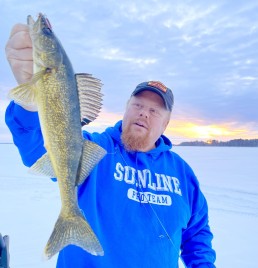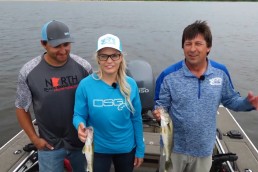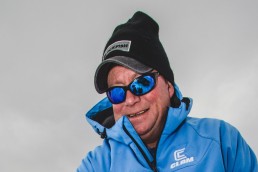Hour of Power Walleyes
SHARE THIS POST
As large lakes gain more ice almost every night, ice thickness starts giving the green light for machine travel. The good news is, when there is more ice, anglers can get to spots that were out of reach a few weeks before. But on our way to good structure and spots loaded with walleyes, don’t forget ice safety.
Eight inches of solid ice is perfect for light machinery such as snowmobiles and four-wheelers. I recommend a solid 10 to 12 inches of black ice for bigger machines like side-by-sides. These machines are considerably heavier, even before they’re loaded up with must-have gear and a few well-fed anglers.
Grab your auger and walk ahead to RAZR some holes to measure ice thickness before waving the machine driver up to the last-known measure of ice. I wear my AFTCO Reaper Hoodie without a jacket for this task; it keeps me warm and it’s breathable, so sweating isn’t an issue.
Those who drill and measure make it safely. There is a lot of ice safety information online. Don’t skip this step before going ice fishing.
RAZR and Leave
Most lakes in the Midwest have a relatively slow day-bite for walleyes, with the notable exception of Lake of the Woods, Upper Red Lake and other stained-water lakes. So, the objective is to arrive to the spot early enough to drill and set up for the evening bite. Make your setup noise early and get ready for the influx of walleyes at dark. Many times, anglers set up on a good-looking drop-off or point on the structure that walleyes forgot about. This is followed by running and drilling holes on nearby edges. Then, finding and catching fish last-minute in the dark…while wishing you had been in that spot earlier.
The best thing you can do is drill holes during setup time on surrounding breaks, point and saddles on the structures nearby. It is a perfect plan. Just remember that your drilled holes may also be found for other anglers to enjoy. On public waters, anglers are free to fish wherever they want to. Don’t drill out too many spots. Drill just as many holes as you think you can fish.
My new favorite spot
I have always found lake maps intriguing—the lay of the land, the shape of a lake and the structures within. Ancient glaciers carved into the land mass, creating the lake, its depth and features. My Humminbird Helix has built-in maps for a lot of popular lakes. I add the VX Digital Map Chart Card from LakeMaster Maps. With vector-accelerated technology, it provides exceptional map performance and customizable color pallets (anglers pick colors and shading). It has updated surveyed lakes plus shoreline aerial imagery which is helpful for trying to figure out where to begin fishing. I use Amped Outdoors 12V 32Ah lithium batteries and never run out of juice.
Pro Tip: Pick areas on the lake before you go. Mark waypoints that scream “walleye.” Walleyes are creatures of edges, but some lakes have hundreds of miles of edges!
I remember (not too far in the distant past) holding a plastic or paper map, trying to make sense out of basic depth lines while navigating a sled using a handheld GPS without contour lines—just a waypoint. Technology for ice anglers has come a long way! There is so much information available that it’s hard to choose where to fish first. Every ice season, I see something different on the map, go fish it and find a pile of walleyes—and a new favorite spot is born!
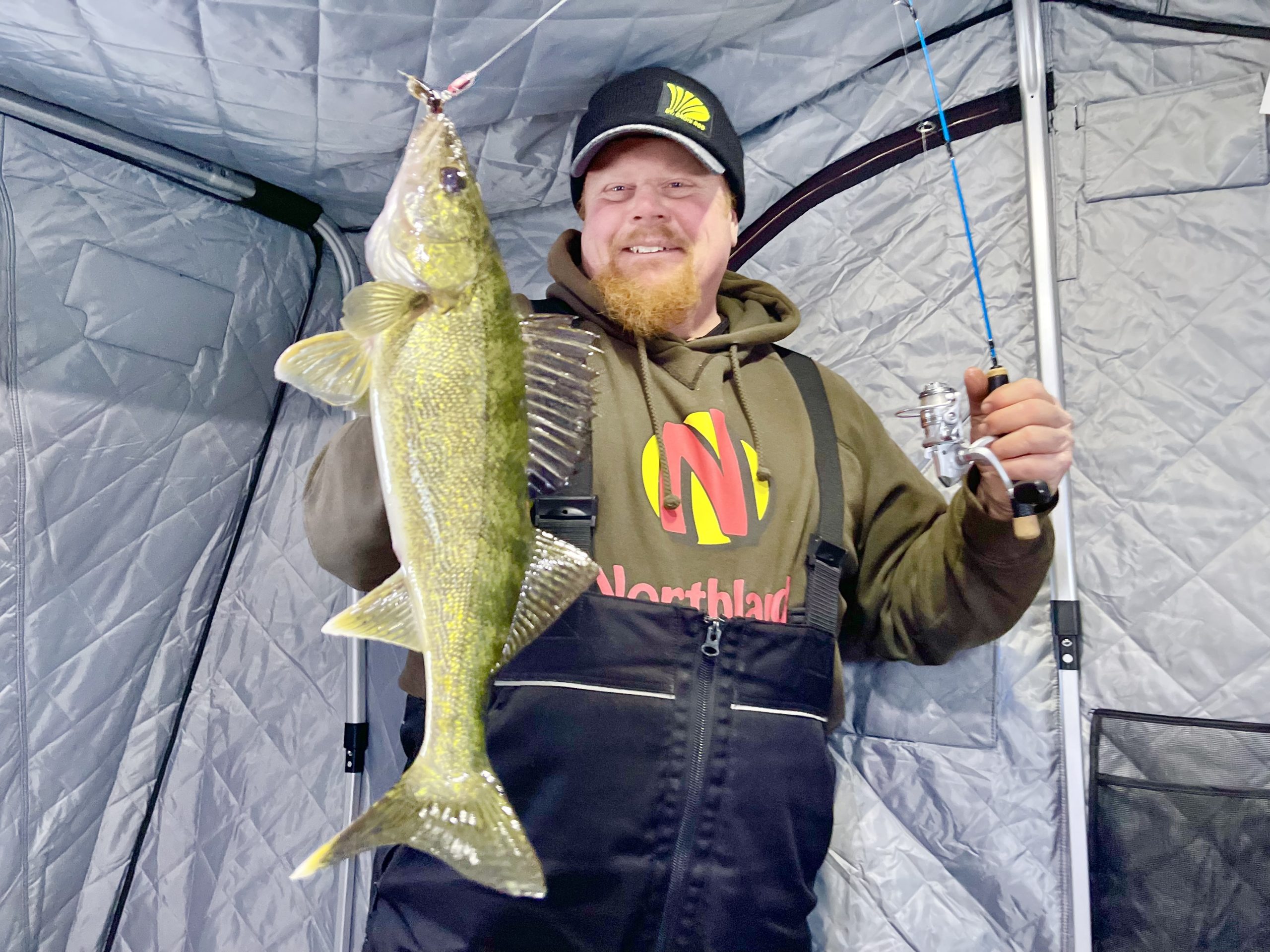
Tackle and cadence
I have never been known to bring too few rods. It is always better to have extra lines. I put my Humminbird Helix with MEGA Live in the middle hole so I’m able to see every line we use in the Otter shelter.
Pro Tip: I RAZR holes with my Synthetic Ultra 8-inch, hitting reverse on the drill after I have passed through the ice. This technique flushes shavings and slush down the hole, saving a lot of time hole-cleaning.
For ice tackle, I start with a 1/4-ounce Northland Glass BuckShot Spoon in perch patterns. I use the same-sized Coffin Spoon as a search bait and keep a 1/4-ounce Red Glo Bro Bug Spoon at the ready if the fish are finicky. Always tip spoons with a minnow head or head and torso (the bloody stump).
When fishing with multiple people, vary the jigging cadence. If everybody rips the spoon, walleyes may pass by as it looks like a fight. One person jigs a sweep and then follows with three softer shakes, while the others use 1- to 2-inch swimming strokes. The walleyes will tell you which cadence they want; then recreate that motion on everyone’s lines.
Are you enjoying this post?
You can be among the first to get the latest info on where to go, what to use and how to use it!
St. Croix’s Custom Ice 32-inch Medium Fast rod is a perfect match for spoon fishing. For walleyes that won’t hit the spoons, use a 32-inch Medium Deadeye rod with a chunky live minnow on a #4 Gamakatsu Red Octopus-style hook and a split shot. I set up some rods and live minnows on iFishPro tip-ups outside the Otter hub. I like this style of tip-up; it allows me to reel in a fish on a rod, not hand-over-hand with line all over the ice like old-school tip-ups.
I use a variety of line:
• On the spoon rods, use Sunline FC-Ice 5- to 6-pound Fluorocarbon
• On the deadstick, use 4- to 5-pound FC-Ice Fluorocarbon
• Clear Sunline FC-Ice is my favorite on all rods for all species.
• I use Sunline Braid SX1 in 8- or 10-pound if I am in a fish house or it it’s above freezing. It’s coated ,so there are fewer bubbles and static on your sonar.
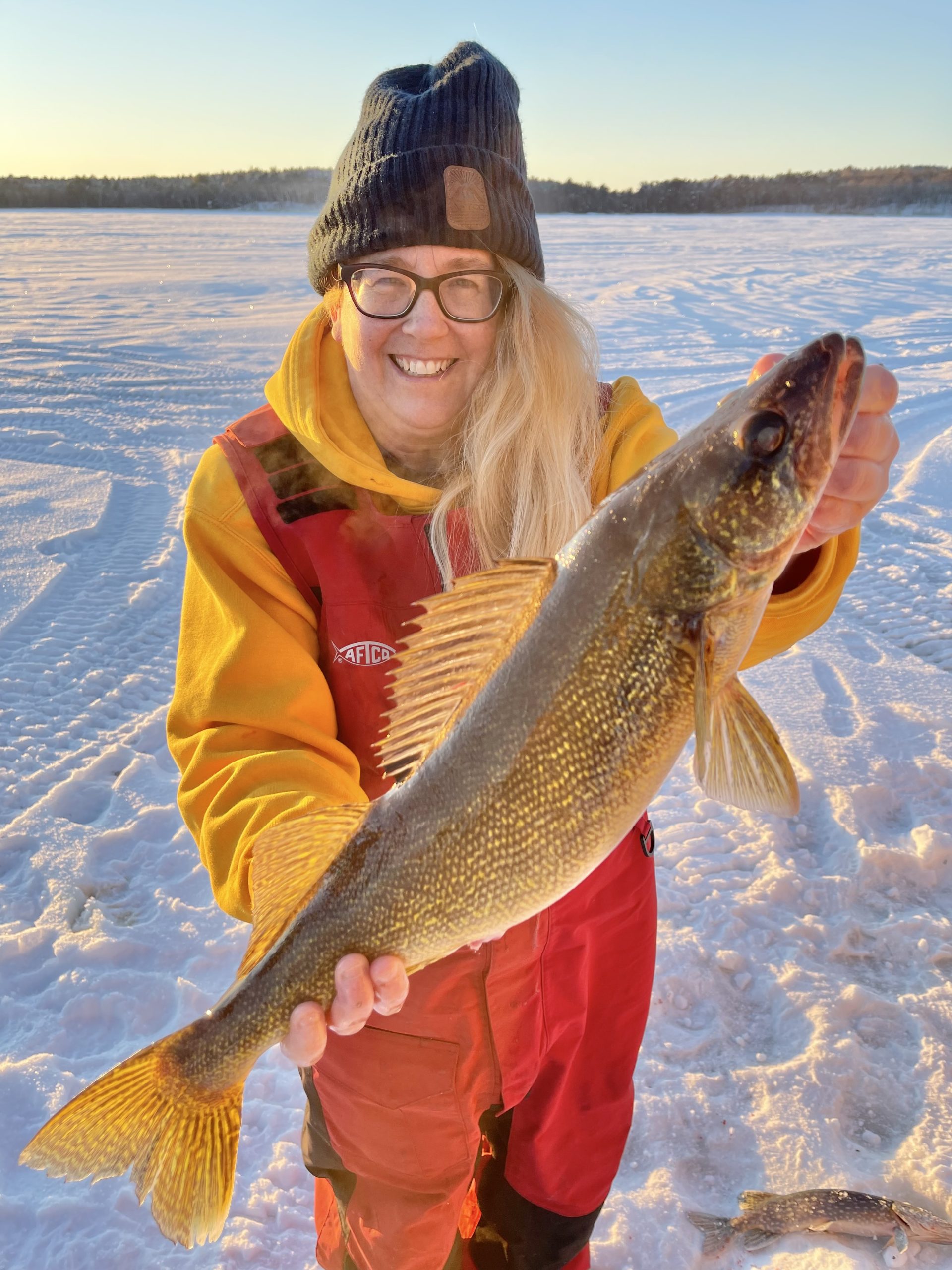
The “Hour of Power”
On many days of guided ice trips, we catch walleyes during the day—but not on purpose. I actually target perch or crappies until it gets close to setup time for walleyes. Typically, in the clear glacial lakes near my home, daytime walleye fishing is uneventful. We do catch them after RAZRing a ton of holes through weed beds, steep breaks and basins. If we get some snow or wind—and with the perfect barometer—we nail walleyes during the day. But the two-pronged, multi-species approach keeps us on action.
Hole-drilling and setup must be done before the Hour of Power when walleyes swim and eat. There have been times when I’ve gone to the walleye spot a few hours early and they’re already biting. Then the next day, we set up at noon and nothing bites until 4 p.m.
Watch approaching weather and barometer readings so you know when you may have to head to the walleye spot early. Another reading I use on my cell phone is the Sun and Moon Table app. I have noticed that when the app rating percentage is high, there is more movement among deer, turkeys and other wildlife. So, there is some magic to this. It’s also true for walleyes.
One more hole
I am guilty of walking holes after the fat walleye sang, and after dark. I’m checking hole after hole, dropping and jigging, hoping for one more last bite. Sometimes, I have found a few straggler walleyes hanging around, and sometimes it’s the biggest one of the day. The hole that is farthest away from lights, talking and splashing sometimes has a walleye-in-waiting.
For this nighttime hole hopping, I wear Fish Monkey Wooly Gloves. I like that I can quickly expose my fingers to bait hooks and touch walleyes—and then cover my fingertips back up to keep them warm. For breaking down camp, packing up and riding machines, I use Fish Monkey Yeti Gloves. Before this type of glove technology existed, I had gotten frostbitten several times over the years and it takes a toll on your fingertip circulation. I’m thankful for advancements in clothing for ice anglers, too!
Outdoor communicator Brian “Bro” Brosdahl lives in northern Minnesota and is a walleye guide in the Cass Lake, Leech Lake and Lake Winnibigoshish areas. Bro is a four-season fisherman and is especially known for his ice fishing knowledge and skills. For guide inquiries, contact: brosguideservice.com.
MWO
SHARE THIS POST
You may also like...
Did you enjoy this post?
You can be among the first to get the latest info on where to go, what to use and how to use it!
Brian 'Bro' Brosdahl
Outdoor communicator Brian “Bro” Brosdahl lives in northern Minnesota. He is a walleye guide in the Cass Lake, Leech Lake and Lake Winnibigoshish areas. He is sponsored by Northland Fishing Tackle, Frabill/Plano, Aqua-Vu, Humminbird/Minn Kota, St. Croix Rods, Ranger Boats, and Evinrude. Guide inquiries: brosguideservice.com. Follow on social media.
